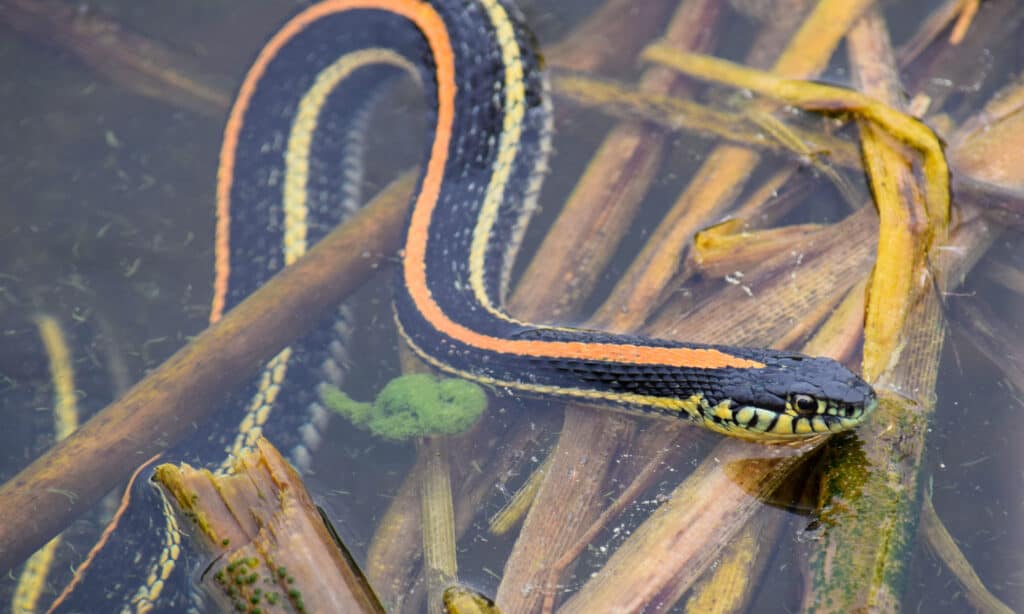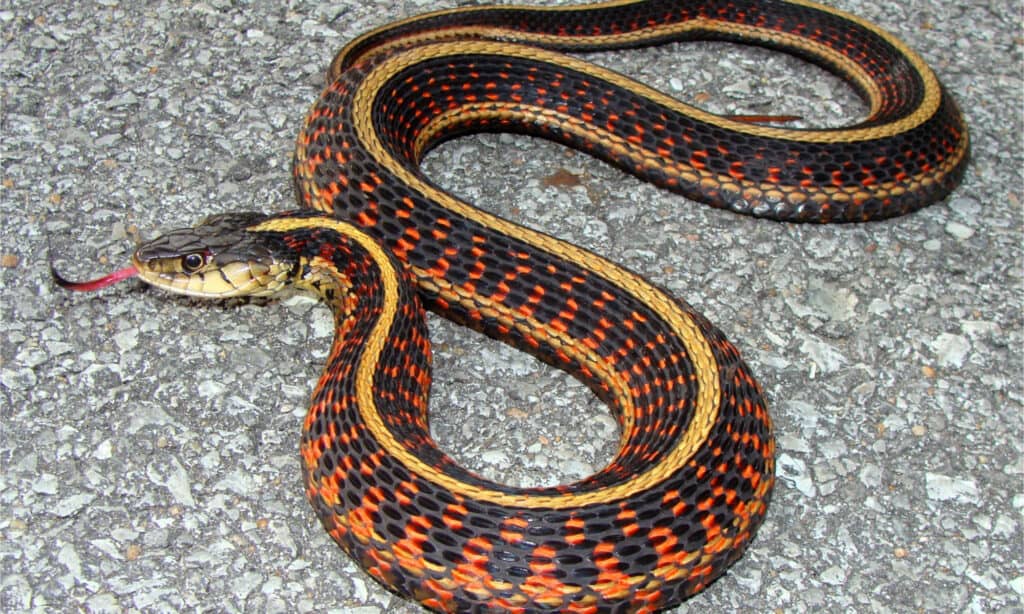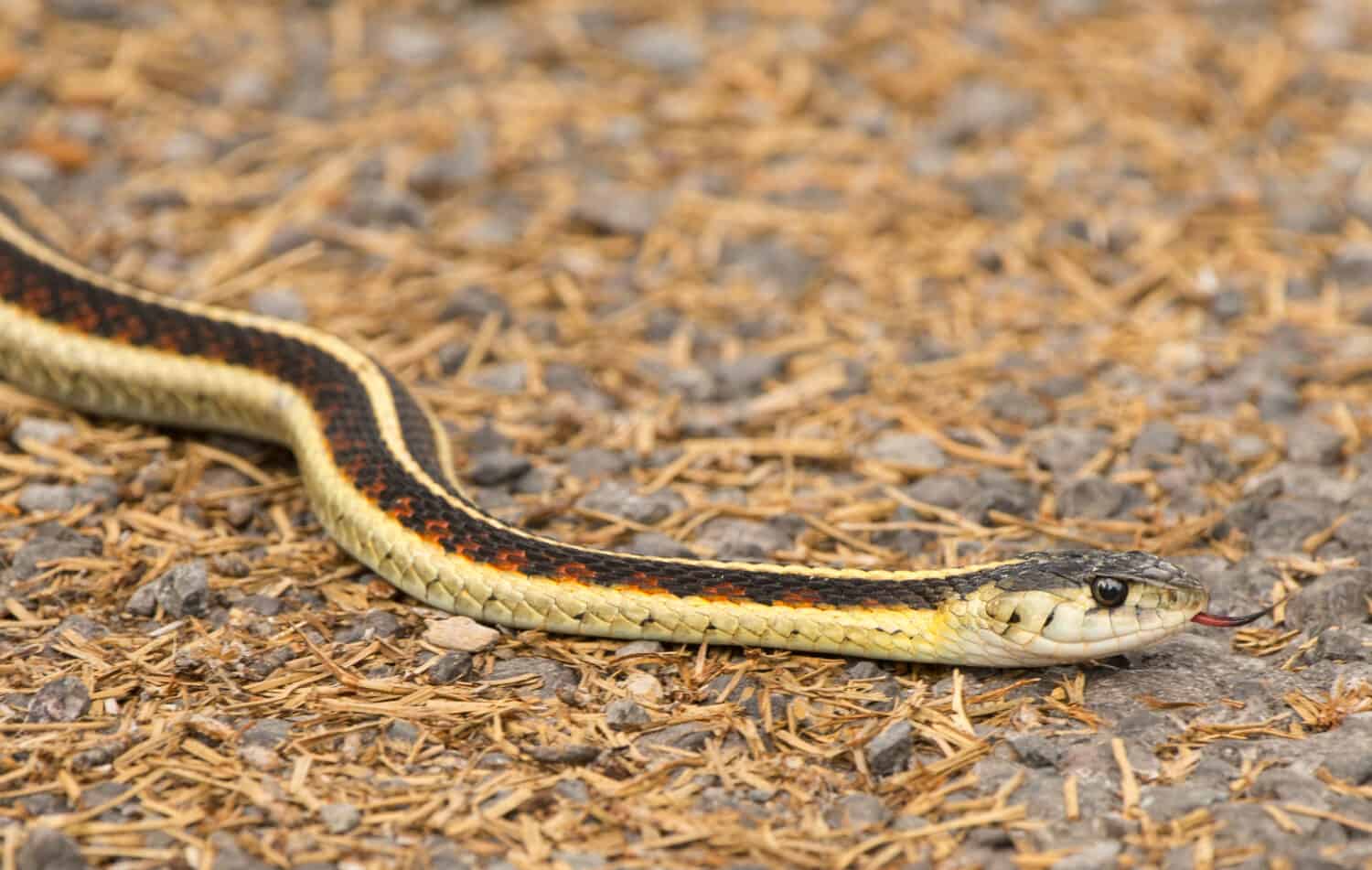Wyoming is best-known for its rugged mountains and vast plains, both of which are home to thousands of different species of plants and animals. From massive bison to pretty little hummingbirds, there’s something for everyone to admire. However, if you’re out and about in Wyoming then you might also come across some snakes. There are 15 species of snakes in the state, including two venomous rattlesnakes. However, there are also a few water snakes in Wyoming. Although these are not classed as being true water snakes — as only snakes in the Nerodia genus are deemed that — they are semi-aquatic garter snakes and commonly live and hunt in and around water.
1. Plains Garter Snake (Thamnophis radix)

Plains garter snakes are excellent swimmers and prey on a variety of fish and amphibians.
©Alyssa Metro/Shutterstock.com
The first garter snake on our list is the plains garter snake which only inhabits the area to the east of the Continental Divide and at elevations below 6,500 feet. They typically live in areas close to a source of water, particularly streams, ponds, and sloughs. They are primarily diurnal and prey mainly on amphibians, slugs, and earthworms. Plains garter snakes hunt by grabbing their prey and swallowing them alive. They do not pose a threat to humans, but they may sometimes bite in self-defence. They also sometimes defecate or release a foul-smelling musk to deter predators. However, they often flee into the water to escape the threat.
Plains garter snakes are approximately three feet long and are dark brown to greenish brown. They also have a single yellow or orange stripe down the center of their back and a lateral stripe on each side which is located on the third and fourth rows of scales. Plains garter snakes also often have a row of black spots between their stripes and several distinctive yellow spots on the top of their head.
Plains garter snakes typically overwinter in rodent burrows and rocky crevices, but can often be seen basking outside on warm afternoons. However, they are mainly active between April and September. The females give birth from late June to early September and litters can consist of between nine and 21 neonates.
2. Red-Sided Garter Snake (Thamnophis sirtalis parietalis)

Red-sided garter snakes are named for the striking red markings between their stripes.
©Matt Jeppson/Shutterstock.com
The next water snake in Wyoming is the red-sided garter snake which is one of two subspecies of the common garter snake to occur in the state. Red-sided garter snakes mainly live in the northern and eastern regions of the Wyoming. They almost always live close to a permanent water source, such as streams, rivers, ponds, marshes, and even drainage ditches. However, during the winter they tend to inhabit rocky crevices and banks, crayfish burrows, and abandoned mammal burrows.
Red-sided garter snakes can reach 49 inches long, although they are often smaller. They are typically dark green to black and have three yellow stripes — a dorsal stripe and two lateral stripes. They also have vibrant red or orange vertical bars between their stripes on the dark background color.
Red-sided garter snakes are active between March and November. They typically mate in the spring when they emerge from brumation. However, they may occasionally breed in the fall, with the females retaining the sperm inside them until the following spring. Red-sided garter snakes are ovoviviparous and give birth to live young in the late summer. They are predominantly active during the daytime and prey on a variety of frogs, toads, salamanders, earthworms, and small fish.
3. Valley Garter Snake (Thamnophis sirtalis fitchi)

Valley garter snakes only live in the western region of Wyoming.
©Jennifer Bosvert/Shutterstock.com
The second subspecies of the common garter snake to inhabit Wyoming is the valley garter snake. Valley garter snakes are typically 18 to 36 inches long and have a brown to black ground color. They also have three yellow stripes, with the two lateral stripes being on the second and third row of scales. Like the red-sided garter snakes, these snakes have a series of vertical red bars on their sides. They are black on the top of their head, but have yellow chins and bellies.
Valley garter snakes are restricted to only the western edge of the state in Lincoln, Teton, and Uinta counties. They can live in a variety of habitats, but again are closely associated with permanent areas of water. They can often be found hiding underneath rocks and logs near to the water’s edge and will often flee into the water at the first sign of danger. Valley garter snakes prey on a wide range of small fish, frogs, toads, salamanders, earthworms, and slugs. They are diurnal but may hunt during the night in the frog breeding season. Valley garter snakes, along with red-sided garter snakes, are mildly venomous to their prey but are not dangerous to humans.
Like the other garter snakes in the state, valley garter snakes mate during the spring. The neonates are born in July and August and are typically five to nine inches long. Litters can consist of up to 40 individuals.
The photo featured at the top of this post is © iStock.com/Wildnerdpix
Discover the "Monster" Snake 5X Bigger than an Anaconda
Every day A-Z Animals sends out some of the most incredible facts in the world from our free newsletter. Want to discover the 10 most beautiful snakes in the world, a "snake island" where you're never more than 3 feet from danger, or a "monster" snake 5X larger than an anaconda? Then sign up right now and you'll start receiving our daily newsletter absolutely free.
Thank you for reading! Have some feedback for us? Contact the AZ Animals editorial team.






